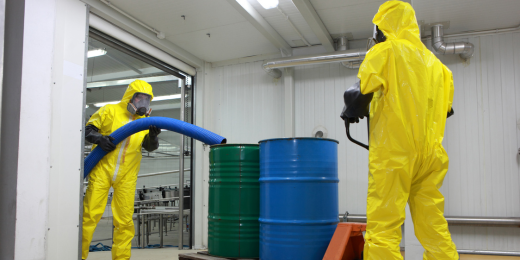The 15-Second Trick For Reclaim Waste
The 15-Second Trick For Reclaim Waste
Blog Article
Facts About Reclaim Waste Uncovered
Table of ContentsThe Basic Principles Of Reclaim Waste 10 Easy Facts About Reclaim Waste DescribedUnknown Facts About Reclaim WasteReclaim Waste for BeginnersNot known Incorrect Statements About Reclaim Waste
Domestic sewer waste refers to the waste and items from a domestic septic tank. The proper management and disposal of domestic sewer waste call for liquid waste to be moved to a sewage treatment plant where the correct approaches and equipment are used to purify and dispose of waste.
Industrial waste often includes prospective dangers, such as flammable materials or a mix of fluid and strong waste items, and needs an advanced and in-depth disposal procedure. The disposal of commercial waste normally involves the filtration of waste prior to transport to guarantee risk-free and appropriate disposal. Industrial waste is created from by-products and drainage of industrial procedures and production.
This kind of waste can not make use of the very same sewer monitoring transportation or processes as septic or industrial liquids. The hazardous waste monitoring procedure requires the inspection and testing of fluid waste before it goes through the disposal procedure (liquid waste removal melbourne). Runoff waste is the fluid waste that comes from drainage and excess stormwater in highly inhabited locations or cities
Overflow waste can trigger contamination and flooding if not handled effectively. Ensuring proper waste administration can avoid catastrophes and decrease ecological damage.
How Reclaim Waste can Save You Time, Stress, and Money.
Get in touch with PROS Services today to find out regarding our waste monitoring and disposal solutions and the correct methods to take care of the fluid waste you produce.
(https://reclaimwaste1.blog.ss-blog.jp/2024-11-12?1731425991)This supposed 'wastewater' is not just a vital resource but, after treatment, will certainly be released to our land, rivers or the ocean. Made use of water from toilets, showers, baths, kitchen area sinks, laundries and industrial processes is known as wastewater.

water utilized to cool equipment or tidy plant and equipment). Stormwater, a form of wastewater, is drainage that flows from agricultural and city locations such as roofs, parks, yards, roadways, paths and rain gutters right into stormwater drains, after rainfall. Stormwater streams untreated straight to regional creeks or rivers, eventually reaching the sea.
Some Known Incorrect Statements About Reclaim Waste
In Queensland, most wastewater is treated at sewage therapy plants. Wastewater is carried from residential or commercial websites with a system of sewers and pump stations, called sewage reticulation, to a sewage treatment plant. Local federal governments construct, keep and run most sewage treatment plants. Operators are certified under the Environmental Protection Act 1994 to discharge treated wastewater at an appropriate ecological requirement into rivers.
The Division of Natural Resources recommends city governments concerning handling, operating and maintaining sewerage systems and therapy plants. In unsewered areas, city governments may require owners to install private or house sewer therapy systems to treat domestic wastewater from commodes, cooking areas, bathrooms and laundries. The Department of Natural Resources authorises using house systems when they are proven to be effective.
The majority of stormwater receives no therapy. In some new subdivisions, treatment of some stormwater to get rid of clutter, sand and crushed rock has actually started utilizing gross pollutant traps. Wastewater treatment happens in 4 phases: Removes solid issue. Larger solids, such as plastics and various other things mistakenly released to sewage systems, are gotten rid of when wastewater is passed via screens.
Wastewater then moves right into large containers where solids work out and are removed as sludge. Oil and residue are skimmed from the surface area. Utilizes small living microorganisms understands as micro-organisms to damage down and eliminate remaining liquified wastes and great bits. Micro-organisms and wastes are incorporated in the sludge. Removes nitrogen and phosphorus nutrients that might cause algal blooms in our rivers and threaten water life.
What Does Reclaim Waste Do?
Nutrient removal is not offered at all sewer therapy plants because it requires costly specialised devices. Clear fluid effluent generated after therapy may still consist of disease-causing micro-organisms - industrial wastewater treatment.

This usually implies wastewater needs to be dealt with or contaminants eliminated before it can be discharged to waterways. Many wastewater moves into the sewerage system. Under the Act, local federal governments administer authorizations and licences for ecologically pertinent tasks (ERAs) entailing wastewater launches that could have a regional influence. The department administers approvals and licences to Periods entailing wastewater releases that may have a regional or statewide influence.
Little Known Questions About Reclaim Waste.
Or else, samples are considered laboratory evaluation. Frequently many examinations are required to develop the levels of each of the various toxins such as oils, hefty steels and chemicals in water. Monitoring supplies accurate details find more regarding water top quality and can confirm that licence conditions are being satisfied. The information acquired via surveillance gives the basis for making water top quality decisions.
Report this page